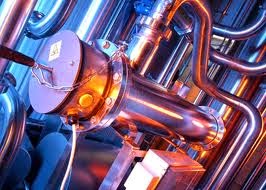The global UV
disinfection equipment market was valued at USD 993.4 million in 2012
and is expected to grow at a CAGR of 14.1% from 2013 to 2019, to
reach an estimated value of USD 2.5 billion in 2019.
Browse UV
Disinfection Equipment Market Report With Full TOC at
http://www.transparencymarketresearch.com/ultraviolet-disinfection-equipment.html
The UV disinfection
market is booming due to the increasing safety concerns of the users
which is inducing them to switch from the customary chlorine based
disinfection to UV based disinfection. Several other benefits
associated with the UV disinfection including its residue-less
functioning, low installation and operation cost and ease of
maintenance makes it the most sought after techniques for
disinfection.
Government
initiatives for providing safe drinking water to citizens are further
increasing the scope of UV disinfection equipment. The fast growth of
healthcare and chemical industries is offering opportunities for the
air and surface segments of the UV disinfection equipment market.
In many places, the
combination of ozone and UV disinfection is being used to create
multiple barriers for Cryptosporidium (a disease causing
gastrointestinal illness and diarrhea) and Giardia (the protozoan
parasites causing Giardiasis). Where the average capital cost of
Cryptosporidium inactivation by ozone is USD 8.1 million, it is USD
4.6 million for the combination of ozone and UV. Similarly, the
annual operation and maintenance cost for water disinfection set-up
of ozone is USD 460,000, while the same is USD 60,000 in case of
disinfection set-up comprising a combination of ozone and UV.
While chlorine takes
around 15-20 minutes of treatment time in the contact tank, UV
treatment takes only 6-10 seconds. Being cost effective, UV treatment
technique is gaining the market share.
One of the rules of
EPA (Environmental Protection Agency) in relation to drinking water
treatment is Long Term 2 (LT2) Surface Water Treatment Rule under
which all public water systems in the U.S. that use surface water or
ground water under the direct influence of surface water, are
required to reduce source water Cryptosporidium levels by 2-logs
(99%). Cryptosporidium microorganisms are resistant to chlorine,
which is giving an opportunity for microfiltration, ozonation and UV
disinfection.
Similar regulations
were put into effect in the U.K. named Water Supply (Water Quality)
Regulations introduced by the Drinking Water Inspectorate (DWI) in
2000 and further amended in 2007. Also, the U.K. Water Industry
Research (UKWIR) is currently working on a project to determine the
efficacy of UV disinfection and based on the observations will make
recommendations on the operational guidelines for UV disinfection in
the U.K.
In China, Office of
the National Health and Family Planning Commission (NHFPC) released a
draft in November 2013 dictating the use of newer technology in
treatment of drinking water products by companies in this domain.
Health problems due
to unavailability of safe drinking water have been one of the major
reasons for the outbreak of diseases in developing countries.
Contaminated water is home to microorganisms which cause several
diseases including diarrhea, cholera, and hepatitis. Every year these
diseases lead to 5 million deaths globally. This has increased
concerns of the governments to improve the safety level of water.
Several developing countries have been using chlorination for the
disinfection of public water for a long time. However, advent of new
diseases such as Cryptosporidium and Legionella pnemophilla, which
are resistant to chlorine, has been compelling governments in
countries such as China and South Africa to use newer technologies to
tackle the health hazards caused by contaminated or unsafe water.
UV Light Emitting
Diode (LED) is a new technology launched in 2012 which is picking up
in the market at a fast pace due to its energy efficiency and compact
size. Where the average annual energy consumption of a traditional UV
lamp is around USD 4,562 per annum, the same for a UV LED based
disinfection system costs around USD 279 per annum.
Geographically,
North America was the market leader in 2012 followed by Asia Pacific
and Europe. Among the regions, the North American market is expected
to hold its leadership with the increased market share during
2013-2019 which can be attributed to the advanced water treatment
technologies in the United States and the increasing healthcare
industry.
The UV disinfection
equipment market is segmented as follows:
UV Disinfection
Equipment Market, By Segment
Global UV
disinfection equipment market share, by segment (by value)
Water
Waste water
Air
Food and
beverage
Surface
UV Disinfection
Equipment Market, By Region
North America
Europe
Asia Pacific
Rest of the
World (RoW)
Browse Consumer
Goods Market Reports @
http://www.transparencymarketresearch.com/consumer-goods-market-reports-7.html
About Us
Transparency Market
Research is a global market intelligence company, providing global
business information reports and services. Our exclusive blend of
quantitative forecasting and trends analysis provides forward-looking
insight for thousands of decision makers. Our experienced team of
Analysts, Researchers, and Consultants, use proprietary data sources
and various tools and techniques to gather, and analyze information.
Our data repository
is continuously updated and revised by a team of research experts, so
that it always reflects the latest trends and information. With a
broad research and analysis capability, Transparency Market Research
employs rigorous primary and secondary research techniques in
developing distinctive data sets and research material for business
reports.
Contact
Ms. Sheela AK
90 Sate Street,
Suite 700
Albany, NY 12207
Tel: +1-518-618-1030
USA - Canada Toll
Free: 866-552-3453
Email:
sales@transparencymarketresearch.com

No comments:
Post a Comment